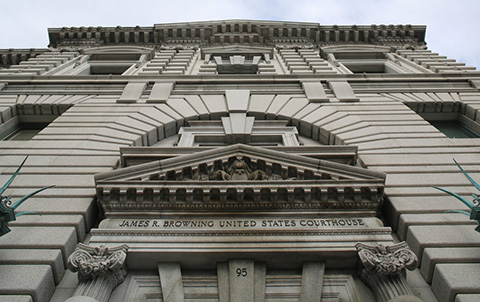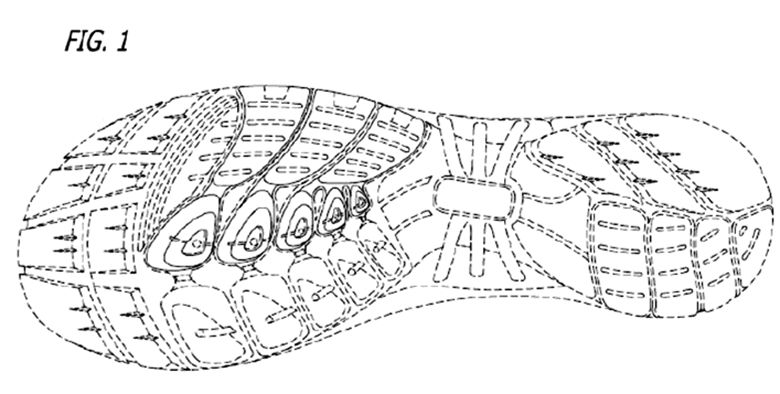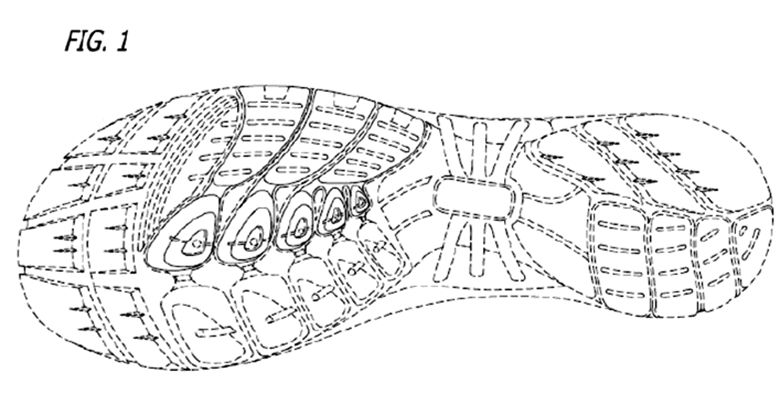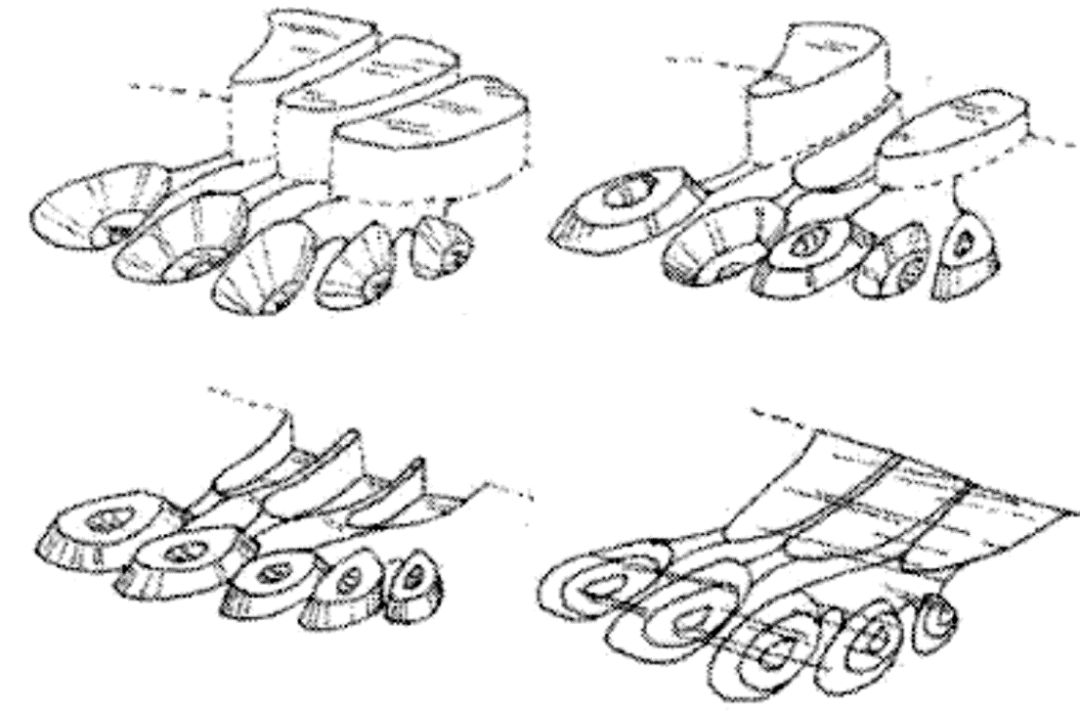没收到验证邮件?请确认邮箱是否正确或 重新发送邮件

#文章由作者授权发表,未经许可,禁止转载,文章不代表IPRdaily立场#
发布:IPRdaily中文网(IPRdaily.cn)
作者:Danielle Anne Phillip 律师 及Paul Lunsford律师
供稿:Brinks Gilson & Lione律师事务所
原标题:Maatita案:联邦巡回法院对检测外观设计专利增加新方
一项外观设计专利可否基于一个2D插图(Illustration)对多个3D实施例(Embodiments)提出权利要求申请?美国联邦巡回上诉法院(联邦巡回法院)近期撤销了一项专利审判和上诉委员会(PTAB)的裁决,创造了一个“基于有限的、2D插图”对装饰性特征描述不明确(Indefiniteness)进行判定的新测试。
本案专利申请人Ron Maatita,递交了一份美国外观设计专利申请(No. 29/404,677 ,未公开),其中对运动鞋底部的一系列特征提出权利要求保护。如下图FIG 1所示,鞋底上半部分中间五个横向圆形特征(实线)为请求的外观设计保护,其余鞋底所有虚线部分为放弃保护的范围。这一申请包含两幅2D鞋底绘图,两幅绘图只有鞋底放弃部分的虚线构图不同。

在专利审查阶段,审查员最终根据35 U.S.C. § 112条以权利要求范围不明确驳回申请,审查员的理由是2D平面图对设计中所要求保护的特征无法全面呈现,因此可引起对设计特征深度和轮廓(Depth and contour)多种的诠释。特别是,审查员认为对具有3D本质的特征,申请只披露了其2D平面图。在最终驳回裁决书中,审查员对请求保护的特征罗列了四种可能的3D实施例(下图所示)。因为这些实施例具有不同的可专利性差异,审查员认为一项权利要求不可以覆盖其所有范围。审查员的观点得到PTAB的支持。

本年8月,联邦巡回法院撤销了PTAB的裁决。巡回法院认为“§ 112条所要求的权利要求范围明确的目的在于……保证披露信息足以清晰,以提示潜在竞争者(所属领域专业人员)请求保护的设计是什么 – 及因此会侵犯什么。”法院将“权利要求不明确标准(standard for indefiniteness)”与“侵权标准”相结合,采用Egyptian Goddess, Inc. v. Swisa, Inc.案中的测试。在评估范围不明确的设计专利申请时,法院陈述“如果一名所属领域专业人员像普通观察者一样来看设计专利,基于权利要求和视觉信息披露不能够合理确定性地(Reasonable certainty)理解设计专利的范围,则外观设计专利根据§ 112条为权利要求范围不明确(Indefinite)。”“对于普通观察者来说只要可以合理确定性地明确发明的范围,一项外观设计专利可以在一项权利要求内披露多个实施例,并可以使用多个绘图来完成。”
联邦巡回法院驳回了PTAB以下观点:所要求保护的设计专利权利要求不明确,因为2D平面图可以不同方式应用于3D特征中。法院认为“所要求呈现的细节程度,应该取决于所要求保护的设计物品是否能够被2D、平面绘图来定义。”PTAB认为鞋底部表面不同的深度会影响所要求保护特征的视觉印象,这一观点并未说服联邦巡回法院。“事实上鞋底可以具有3D外观面,但这并不改变其装饰性设计能够以2D、平面图角度来披露和进行判定这一事实 – 并且本案申请人的2D绘图清晰地展示了从鞋底部应该看到的视角。”相反,“决定不披露(鞋底)所有可能的深度,不会阻碍一名普通观察者对本案设计的理解,因为设计可以通过绘图中的2D视角被理解。”
联邦巡回法院的这一裁决可能会对外观设计专利申请的递交策略带来巨大影响。通常,外观设计专利申请包含若干图形,以多种平面图和正交视图来显示所请求保护的装饰性特征。对于大型的3D设计,这一递交策略很可能保持不变。
但是,对仅就产品一个单面进行装饰的装饰性特征而言,本案裁决可能会激励申请人从较少的视角提供较少的图示,来尽可能大的获得权利要求范围。
本案裁决还可能对尝试避免侵权的商业实体造成困扰。更大的外观设计专利权利要求范围造成更高的侵权风险。在对类似于Maatita外观设计专利进行评估时,设计者和制造者将需仔细地从设计专利中所显示的有限视角来检测产品以决策侵权风险。一项设计的3D组件可能并不足以避免对一项只披露了2D视角设计的侵权。
现在还未知本案是否会被继续上诉进行全席审理(en banc)或专利局将申请复审令(petition for certiorari)。包含外观设计专利的争议被最高法院受理的可能性罕见,但鉴于本案裁决的意义重大,有得到进一步审查的可能。
附:英文全文
In re: Maatita: The Federal Circuit Adds a New Dimension to the Design Patent Indefiniteness Standard
Can a design patent claim multiple three-dimensional embodiments based on a two-dimensional illustration? The U.S. Court of Appeals for the Federal Circuit (Federal Circuit) has reversed the Patent Trial and Appeal Board (PTAB), creating a new test for the indefiniteness of claimed ornamental features based on limited, two-dimensional illustrations. In re: Maatita, No. 2017-2037 (Fed. Cir. August 20, 2018).
The applicant, Ron Maatita, filed U.S. Design Patent Application No. 29/404,677 (unpublished) claiming a series of features on an athletic shoe bottom. The rest of the shoe bottom was disclaimed. The applicant included two two-dimensional drawings of the shoe bottom which differed only in the unclaimed environment surrounding the claimed features.

Maatita's Claimed Design (dashed lines indicate disclaimed subject matter)
During prosecution, the examiner ultimately rejected the application under 35 U.S.C. § 112 as being indefinite since the two-dimensional plan views left the design open to multiple interpretations regarding depth and contour of the claimed features. Specifically, the applicant disclosed only two-dimensional views for features which were three-dimensional in nature. In a final rejection, the examiner included four different possible three-dimensional embodiments of the claimed features. Because these embodiments were patentably distinct, the examiner argued that they could not be covered by a single claim. The examiner's position was affirmed by the Patent Trial Board of Appeals (PTAB) on March 29, 2017.

Possible Embodiments Presented by the Examiner
On August 20, 2018, the Court of Appeals for the Federal Circuit unanimously reversed the PTAB. The Federal Circuit explained that, "[t]he purpose of § 112's definiteness requirement … is to ensure that the disclosure is clear enough to give potential competitors (who are skilled in the art) notice of what design is claimed – and therefore what would infringe." Maatita, slip op. at 9. The Federal Circuit then linked the standard for indefiniteness to the standard for infringement, adapting a test created by Egyptian Goddess, Inc. v. Swisa, Inc. 543 F.3d 665, 672 (Fed. Cir. 2008) (en banc). In assessing the indefiniteness of a design application of uncertain scope, the Federal Circuit stated that, "a design patent is indefinite under § 112 if one skilled in the art, viewing the design as would an ordinary observer, would not understand the scope of the design with reasonable certainty based on the claim and visual disclosure." Maatita, slip op. at 10. "So long as the scope of the invention is clear with reasonable certainty to an ordinary observer, a design patent can disclose multiple embodiments within its single claim and can use multiple drawings to do so." Id.
Rejecting the PTAB's argument that the claimed design was indefinite because the two-dimensional plan views could be applied to the three-dimensional features in a number of different ways, the Federal Circuit stated that, "the level of detail required should be a function of whether the claimed design for the article is capable of being defined by a two-dimensional, plan- or planar-view illustration." Id. at 12. "The design for an entire shoe … is inherently three dimensional and could not be adequately disclosed with a single, plan-, or planar-view drawing." Id. Comparatively, "[t]he design of a rug … is capable of being viewed and understood in two dimensions through a plan- or planar-view illustration." Id. "Such a claim, with a single drawing, would cover all similarly designed rugs or mats." Id. The Federal Circuit was not persuaded by the PTAB’s argument that the varying surface depths of a shoe bottom impact the visual impression of the claimed features. "[T]he fact that shoe bottoms can have three-dimensional aspects does not change the fact that their ornamental design is capable of being disclosed and judged from a two-dimensional, plan- or planar-view perspective – and that [applicant’s] two-dimensional drawing clearly demonstrates the perspective from which the shoe bottom should be viewed." Id. at 13. Rather, the “decision not to disclose all possible depth choices would not preclude an ordinary observer from understanding the claimed design, since the design is capable from being understood” from the two-dimensional perspective in the drawing. Id.
The Federal Circuit's decision may have a significant impact on the filing strategy for design patent applications. Typically, design patent applications include several figures showing the claimed ornamental features from a variety of plan and orthogonal views. For large, three-dimensional designs, this filing strategy will likely remain the same.
However, for ornamental features adorning only a single surface of a product, this ruling may provide an incentive to provide fewer drawings from fewer perspectives to capture as much scope as possible.
This ruling may also create some concern for commercial entities trying to avoid infringement. Broader design patent claims create a higher risk of infringing a claimed design. When assessing design patents similar to Maatita's, designers and manufacturers will have to carefully examine a product from the limited perspectives shown in the design patent to determine their risk for infringement. A three-dimensional component to a design may not be sufficient to avoid infringement of a claimed design disclosed only from a two-dimensional perspective.
It is not yet clear if this case will be reheard en banc or if the U.S. Patent and Trademark Office will file a petition for certiorari. Disputes involving design patents rarely reach the Supreme Court. However, the significance of this decision may be significant enough to warrant further review.
发布:IPRdaily中文网(IPRdaily.cn)
作者:Danielle Anne Phillip 律师 及Paul Lunsford律师
供稿:Brinks Gilson & Lione律师事务所
编辑:IPRdaily赵珍 校对:IPRdaily纵横君
推荐阅读

“投稿”请投邮箱“iprdaily@163.com”

「关于IPRdaily」
IPRdaily成立于2014年,是全球影响力的知识产权媒体+产业服务平台,致力于连接全球知识产权人,用户汇聚了中国、美国、德国、俄罗斯、以色列、澳大利亚、新加坡、日本、韩国等15个国家和地区的高科技公司、成长型科技企业IP高管、研发人员、法务、政府机构、律所、事务所、科研院校等全球近50多万产业用户(国内25万+海外30万);同时拥有近百万条高质量的技术资源+专利资源,通过媒体构建全球知识产权资产信息第一入口。2016年获启赋资本领投和天使汇跟投的Pre-A轮融资。
(英文官网:iprdaily.com 中文官网:iprdaily.cn)
本文来自Brinks Gilson & Lione律师事务所并经IPRdaily.cn中文网编辑。转载此文章须经权利人同意,并附上出处与作者信息。文章不代表IPRdaily.cn立场,如若转载,请注明出处:“http://www.iprdaily.cn/”

 共发表文章4693篇
共发表文章4693篇文章不错,犒劳下辛苦的作者吧
- 我也说两句
- 还可以输入140个字












